
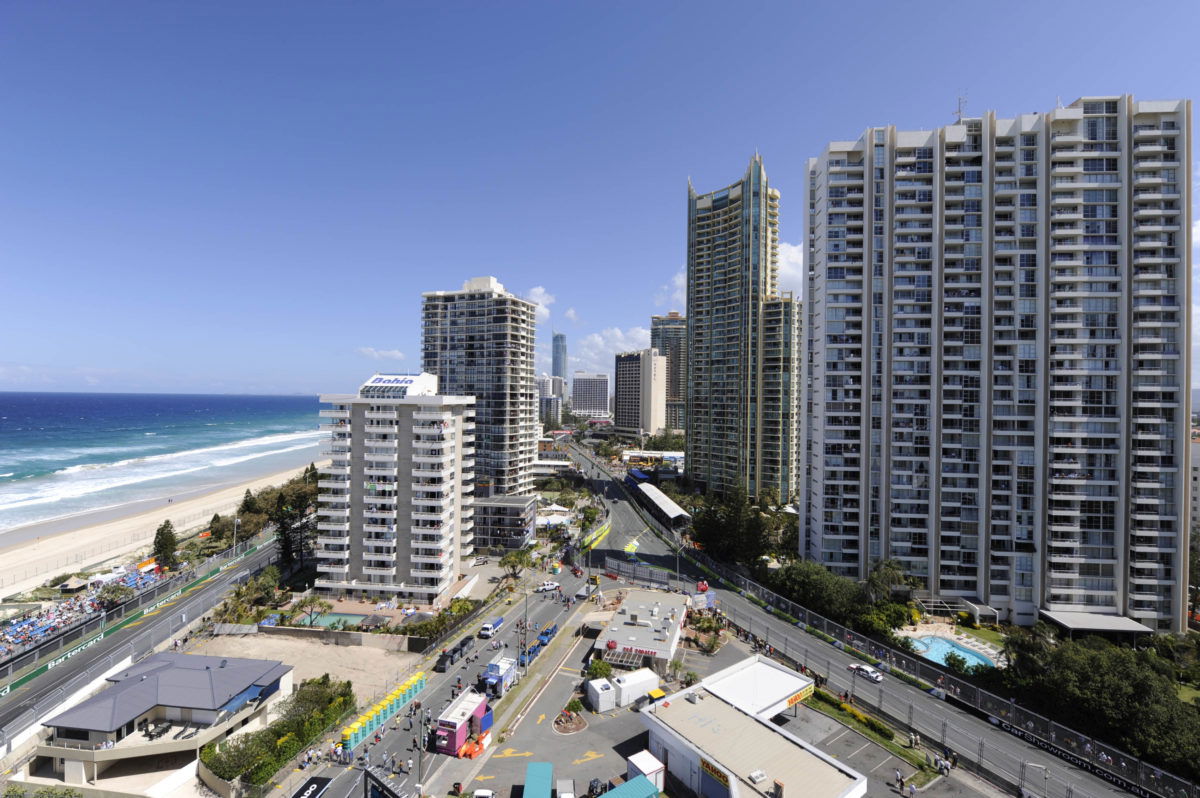
Speedcafe.com continues to attack Coronavirus isolation this week by running a series of extracts from the autobiography of the site’s founder, Brett ‘Crusher’ Murray.
The remaining 100 copies of the book are being sold at a discount of $40 (inc Express Post) with 100 percent of proceeds going to Speedcafe.com’s charity, Motor Racing Ministries. CLICK HERE to buy your copy.
In this final extract for Speedcafe.com, ‘Crusher’ looks at the disaster of the A1 Grand Prix cars not turning up for the 2009 Gold Coast 600 at Surfers Paradise and how it not only almost brought down the event, but the State Government. He was at the coalface to save the event. How did it unfold? Read on!
Chapter 24 of 29: It’s our bloody money
The event business is an emotional one.
You have to live and breathe it and make it your life if you are going to be successful. It’s not like you are selling cans of Coke where you can go home at the end of the day after reaching your quota.
Sure there are some events where you have a limited number of seats, but that is rare in motorsport and was certainly never the case with the Gold Coast street race which was such a big part of my life for so many years.
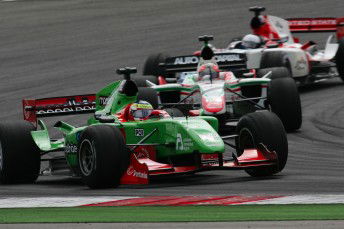
While the event and all its many facets is worthy of a book, there is little doubt the A1 Grand Prix (A1GP) fiasco of 2009 deserves a minimum of a chapter here. That event was the most emotional, frustrating and, ultimately, the most rewarding of my career.
The Gold Coast race was launched in 1991 as the opening round of the CART PPG IndyCar World Series and was used as a political football while it bubbled through the first couple of years, during which time I was a journalist at the Gold Coast Bulletin.
The event became a client of my new PR business in 1993 and that year was a real turning point for its success, due to the arrival of reigning Formula 1 World Champion Nigel Mansell, who had joined Newman/Haas Racing. The involvement of Mansell saw our accredited media numbers jump by hundreds and the Englishman did not disappoint, taking pole and the win on debut.
The second major turning point for the event came in 1998 when the race went from being held in March to its current schedule of October. This was made to avoid clashing with the Formula 1 Australian Grand Prix in Melbourne and to encourage a corporate spend at the other end of the year. An 18-month break gave locals a chance to really miss the event and to have a better appreciation of it when it returned later in the year.
Businesses the length and breadth of the region had their worst March figures since the first event in 1991, proving that the show was an important commercial fixture for Queensland and the Gold Coast.
The Surfers Paradise race is one of the most logistically challenging in the world, with the original 4.5km circuit being built right in the middle of a dense residential and tourist area.
It is like a giant jigsaw puzzle where pieces need to be put in place via a strict minute-by-minute run sheet. Through the years there had been so many outside elements that would put pressure on the event, yet somehow it survived.
The 2000 Olympics; September 11, in 2001; the 2002 Bali bombings; the 2003 Rugby World Cup and different downturns in the economy, had to be combated to ensure the least negative effect as possible. It was a 24/7 job.
One year in the late 1990s, I had a film crew follow me around for part of the week and I was required to keep a diary.
I had 22 hours sleep in two weeks. I would get into bed at 5:30am, Trudi (my wife) would get out to get ready for a day of nursing, and the phone would ring at 6am for my first radio interview.
If something had to be done, we would do it. It was what set us apart from others in the business.
There was also a decent amount of socialising, as you could imagine.
The return of V8 Supercars to the event added a valuable element as a war continued in US open-wheel racing between the Indy Racing League and Champ Car from 1996 for more than a decade.

In 2008 a truce was called between the two bodies with a one-off non-championship event held on the Gold Coast, and appropriately won by Australian Ryan Briscoe, to fulfil contractual agreements.
One of the big stories of that event was the on-going question of whether or not the new-look IndyCar Series would be coming back to Gold Coast, but it would seem that a decision had already been made, with an announcement coming a month later that A1GP had been given the nod.
The A1GP was a unique concept where teams represented countries from around the world in an international open-wheel category powered by Ferrari engines.
There was an on-going air of uncertainty about the series which was controlled by South African diamond entrepreneur Tony Teixeira.
Two weeks after the A1GP deal was announced, the series’ CEO David Clare, who I knew through his time at Champ Car, resigned with ‘personal concerns’ about the organisation, which I conveyed to our own event management.
I was Communications Manager for the event, but behind the scenes had become a lot more than that, with an input into almost every facet of the event from government relations, marketing, PR and sponsorship, to off-track event creation, media centre design, entertainment and scheduling.
I had been living in the United States in 2008 and was being kept up to speed through my client manager, Amanda Cobb, before returning for the month of the race.
I returned to live in Australia in January, 2009, and was always extremely sceptical about the A1GP organisation and whether they would actually show up 10 months later.
While it was my job to remain positive in the marketplace, I believed it was a vital part of my role to keep management informed about anything that could negatively affect the event.
Unfortunately, very little good news ever came about A1GP.
As the race date drew nearer, the lies from the series got bigger and management of the Gold Coast event, which was a joint venture between IMG and the Queensland Government, became more gullible to a point when the hole simply became too deep.
Negative news was almost a weekly occurrence until major stories broke in the July saying A1GP staff were not being paid.
Cutting away all the bullshit, the further we progressed the stronger the stalemate became.
If either the A1GP organisation or the Gold Coast Motor Events Co. announced the event was not going to happen, then there would be an argument of a breach of contract.
As we got closer to the event, it became a total farce, but no one was listening and the position of the Queensland Labor Government was on the line.
I was continually accused of being negative towards the A1GP Series. In truth I was just being a realist, but this resulted in a few heated discussions with event boss, Greg Hooton, who was genuinely a nice guy, but who had been blindsided.
Already, A$1.8 million had been paid in advance to have the show come to town; this had significantly more relevance considering the Government had put up the cash.
The A1GP was running on a skeleton staff, but were trying to make out it was business as usual.
There was one particular meeting that probably stands out, and when I think a serious penny finally dropped.
“Crusher, if they are broke how are they paying their people?” asked Hooton.
“They are paying them with our bloody money,” I replied.
Less than two weeks from the event, nothing had changed – NOTHING!
I was at the Bathurst 1000 and continued to bat away a barrage of media enquiries about the Gold Coast event and the state of the A1GP.
On the Friday night I received an email from A1GP Media Manager Ann Bradshaw saying she had organised an interview with Teixeira with ABC radio in Brisbane.
I was f^#!ing furious.
As if by some miracle, as I drove towards our rented house in Bathurst I picked up a signal which tuned me into an interview between Teixeira and talkback ace Steve Austin, who is a tough interviewer and who I regard as one of the best in the business.
I thought “Oh, f#^!. This is about to turn very, very ugly”.
Fortunately, it seemed the interview was put together at the last minute and Austin’s producer did not have time to do the research. What could have been the ignition of a massive bushfire and media storm bubbled into a fluff piece which Teixeira bluffed his way through.
By this point there was every indication that it had been decided to ostracise me to salvage what they could by dealing directly with the press in conjunction with A1’s own media department.
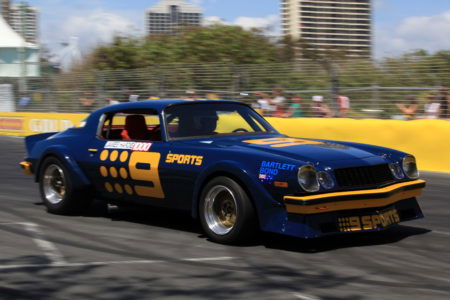 On the Monday (October 12), I had this total realisation that if a Plan B was not created, there was every chance that the Surfers Paradise race would be lost forever and the political fallout would be enormous.
On the Monday (October 12), I had this total realisation that if a Plan B was not created, there was every chance that the Surfers Paradise race would be lost forever and the political fallout would be enormous.
I sent Hooton an email that morning which explained that while I was happy to prepare and distribute media releases as per my agreement, I would no longer be putting my name on the bottom of them and that he should let me know who he wanted as the contact. I did not receive a reply.
I spent the next 12 hours in the car heading back to the Gold Coast and developed a framework for what would become the Pirtek Legends.
My media mate Chris Nixon provided an introduction to the Bowden Family, who live on Queensland’s Sunshine Coast and have one of the finest collections of Australian touring cars.
They agreed to the idea in principle to make their collection available for some of the greatest names in the history of the sport to drive them at Surfers Paradise.
The next phase was ringing the ‘legends’ and getting an understanding of who was available.
Meanwhile I was doing a running budget.
I presented the idea the next day and it was completely hosed down because “A1GP were still coming”.
The biggest leap of faith came on the Thursday when I had to transfer $25,000 from my personal account to the Bowdens so they could start preparation on the cars.
That night there was a private meeting at the house of Supercars boss Tony Cochrane.
It involved Supercars management, major stakeholders and others of influence, including Mick Doohan.
I presented my concept and budgets, and an appropriate ‘fix’ from the Supercars end was also formulated.
The next day the concept was presented to the board, who initially rejected it until Cochrane suggested that if the plan was not accepted, he would stick with his contractual obligations and there would be some serious holes in the TV telecast which would almost certainly end up in legal action.
When I walked into the Gold Coast office on the Friday morning I could not believe what I was seeing.
There were promotional staff still on the phone trying to organise open-top Ferraris for the A1GP drivers’ parade – F#^! ME!
Overnight the A1GP provided a statement announcing they were out of the event and a media conference was held in pit lane at Macintosh Island.
I jumped straight in my car and drove to Dick Johnson’s place where we confirmed a plan for him and his son Steve to be named as joint grand marshals for the event.
The rest of Saturday afternoon was spent confirming all the core elements we had put in place such as cars, drivers, motel rooms and flights. But that was just the beginning.
We had to keep our foot on the gas until the final flag fell the following Sunday afternoon and ensure we did not overlook one single detail.
It was important for every one of our stakeholders to be treated as well as possible and to come away from the event feeling they had been part of something special.
I had made a phone call to an associate in Townsville by the name of Sheree Lineham. Sheree had caught my attention through her handling of the media for the Townsville Supercars event earlier in the year and I negotiated a deal with her to be on standby.
I called her on the way to Dick’s place and instructed her to get on a plane ASAP and not to expect too much sleep.
Her efforts and level of professionalism were invaluable and a later move into political PR saw her as the right arm of Australian Prime Minister, Tony Abbott.
Before the cars hit the track for the first time on the Thursday, we negotiated Pirtek’s sponsorship; re-arranged the on-track schedule; set-up new support-paddock facilities; designed and printed posters and handbooks specifically for the Legends event; confirmed social events for the driver group every night; arranged individual airport transfers, daily news conferences and PR schedules; organised personal thank-you gifts for the drivers and sponsors; ordered personal race suits embroidered with their names, promotional shirts to be worn at media events, media guides and kits with driver profiles and images and a small library of B-roll video for national distribution.
During all this I was also preparing my new website Speedcafe.com for its official launch – another enormous task in itself.
The Pirtek Legends concept was officially launched in the pit lane by Sports Minister Phil Reeves on the Wednesday of race week.
We had several of the old cars at the roll-out where Reeves got absolutely smashed by the media, as you would expect.
It was an unfair attack, given Reeves was not the minister when the A1GP deal was put together and, if it had not been for his faith in my idea and opening the door to Cochrane and Supercars, the Gold Coast event would have been dead in the water.
About 10 minutes into the hammering, I started to get sick of the repeated questions so I ordered the guys in the old cars to fire them up and move into pit lane, drowning out the questions and basically bringing an end to proceedings.
The truth was the media scrum had the right to rip me apart for the ‘stunt’, but I think I had a few favours owed and they went light on me.
The enormity of what we were trying to achieve created opportunity for everyone in my organisation, especially my young event manager Amanda Cobb, who not only stepped up, but learned more through that event than she would in a normal lifetime of regular PR.
One of the most disappointing outcomes was the loss of a friendship with event Chairman Terry Mackenroth, who had been a tremendous supporter of mine and had done so much for the State of Queensland through his political life.
Terry never spoke to me again.
On the Sunday night we held a function at the house I had rented out on the back part of the circuit for all the legends and their partners, my staff and anyone else who had contributed.
I remember walking out on the balcony by myself where I sat with a beer looking down over the track. I remember saying to myself out loud, “How the f#^! did we do that?”
The whole process provided a perfect opportunity for Cochrane to position the Supercars organisation to replace IMG as the promoters of the event from that point, and GCMEC was dissolved.
There was a total new look and feel for the event in 2010 and we even promoted the fact that ‘the band’ had been put back together.
This included Cochrane, former General Manager Geoff Jones, CFO Ken Jeffress, Senior Manager Shane Howard, engineering head John Howe and myself as part of the management team.
A plan was hatched for the Supercars to provide an international angle to the new event in 2010, to tick one of the required boxes for the Queensland Government.
I was given the task of pulling together a list of names overnight that could be presented to the government and the media to whet their appetites.
My original list included Christian Fittipaldi, Scott Pruett, Mark Blundell and several others and, together with the teams, we built it from there.
We again rolled out the Pirtek Legends event and I took it to the next level with the confirmation of the #1 and #2 Ford Falcons that Allan Moffat and Colin Bond had driven to a famous one-two finish at the Bathurst 1000 in 1977.
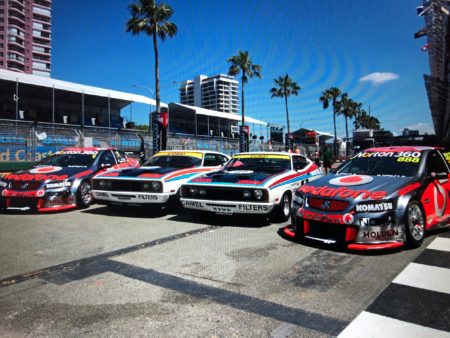 I was kissed on the dick when Roland Dane’s Triple Eight Engineering operation achieved the same thing with its Vodafone cars driven by Craig Lowndes and Jamie Whincup at Mount Panorama two weeks before our scheduled Gold Coast event. A photo of myself with all four cars and drivers was a truly memorable moment and sits on the wall of my office.
I was kissed on the dick when Roland Dane’s Triple Eight Engineering operation achieved the same thing with its Vodafone cars driven by Craig Lowndes and Jamie Whincup at Mount Panorama two weeks before our scheduled Gold Coast event. A photo of myself with all four cars and drivers was a truly memorable moment and sits on the wall of my office.
I also had a shot taken of Dane and Moffat together with the cars. I had it printed and signed by Moffat ‘Welcome to the 1-2 Club’, and gave it to Roland as a Christmas gift. It now proudly sits in his Brisbane dining room.
I am not sure people realise how much that Bathurst achievement meant to Dane, who has made an enormous contribution to the sport in Australia and internationally.
The #2 Falcon came as part of our deal with the Bowden Family, but I had to negotiate a deal for the #1 car with the Australian Motor Racing Museum in Bathurst who had been gifted the vehicle by Moffat many years earlier.
Museum Manager Tim Pike was generous with his enthusiasm for the proposal and we basically struck a deal so I would transport the car and have it prepared, giving the museum as much publicity as possible.
While the Legends would run each day of the event, the #1 car would appear only on the Sunday when it would be driven by Moffat.
It would be the first time the two cars would be driven at reasonable speed on a race track, by their two original drivers, since that magical day in 1977.
Oh, and we needed to get an insurance cover note on the car for at least $500,000.
Moffat arrived on the Saturday night in time for a Legends dinner, attended by more than 300 guests at the Gold Coast Marriott, and was terrific talent.
The next day we had the Legends involved in an autograph session before they prepared for their one and only on-track appearance.
I gave Moffat his specially prepared race suit, then marshaled all the cars into the pit lane.
Pike was standing beside me as the cars were fired up.
“How did you go with that cover note?” he asked.
“Yeah, I have it in my office. I will go and grab it.”
With that, I went to my trackside office and took up the foetal position in the corner as I heard the group of cars leaving the pit lane.
I did not move for almost half an hour until I heard the cars return at the end of the session.
I actually counted them by exhaust note and my heart rate and arsehole returned to a regular beat and size as I identified the last car was back safely.
The truth was, I had been unable to find anyone to insure the car, so I guess for that 30 minutes I was in the personal insurance business.
My heart rate went back to its rev-limiter when I greeted ‘Moff’ back in the pit lane.
He got out of the car, walked straight up to me and poked his finger at my chest.
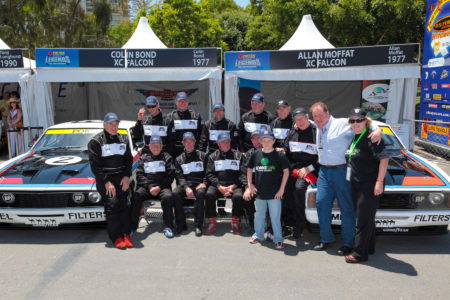 “Don’t ever f#^!ing do that to me again,” he berated me.
“Don’t ever f#^!ing do that to me again,” he berated me.
“That is the most f#^!ing dangerous car I have ever driven. I almost crashed it a dozen times.”
Despite me ‘compromising’ him in such a manner, our friendship grew even stronger after that event and if he ever found out I was in Melbourne and had not asked him to lunch for a steak and a glass of red, I was in trouble.
The international driver concept went to another level in 2011 with enormous interest and teams investing time and extra cash to get the right ‘star’ in their co-driver seat.
The Pirtek Legends concept was dumped, despite its popularity, but the international list read like a serious who’s who.
The preparations for that event were thrown into turmoil when Dan Wheldon was killed and Will Power and Tony Kanaan injured in the final round of the IndyCar Series in Las Vegas.
The whole show had to be reorganised on the run, made even more difficult because Wheldon was a good mate of mine. It was one of the toughest weeks of my career.
As we moved towards the 2012 event there was yet another change of CEO at Supercars, with former Fox employee David Malone getting the gig.
Malone’s job was to get a new TV deal in place and also handle the day-to-day stuff.
A delay in the TV deal almost brought the sport to its knees.
Mine, on the other hand, were smashed with an axe.
“We want you around, you are important to the event, but you have to take a cut,” said Malone.
“Well, David, I find that a little strange because I am employed to directly work on the Gold Coast event and you have just re-signed the naming rights sponsor, who are also my client; the Government is in for more money and corporate sales are better than ever. So, why the f#^! am I taking a pay-cut? Are you taking a pay-cut? Is Cochrane taking a pay-cut?
“Why the f#^! would I agree to take less money than I did in 1993?”
With everything that I had given the event over the years, and my personal financial risk and unwavering commitment to keeping the event afloat in 2009, I was banking on some support from Cochrane, who I rated as one of the best readers of the play I had ever seen.
But when it came time for him to help me out, he failed to go into bat for me.
A long, challenging, exciting, passionate, frustrating, rewarding and valuable era had come to an end.
The A1 fiasco: Timeline
August 2008
There was a meeting between myself, Craig Gore, Kevin Kalkhoven and Alan Jones to discuss A1GP and the possibility of the Team Australia Champ Car team allowing its driver Will Power to drive for the Australian A1GP team in the off-season.
During the discussions it was discovered A1GP had confirmed this as a done deal, as part of their negotiations for a Gold Coast race. Gore and Kalkhoven were furious and made it clear they would not have any association with the A1GP series or any event involving it.
November 11, 2008
To this point, the actual event was the only organisation that had not announced A1GP would be the feature act on the Gold Coast the following October. The series made the announcement and we eventually followed.
November 24, 2008
David Clare resigned as the CEO of A1GP. I had a personal relationship with him after his time at Champ Car. I sent this news and conveyed Clare’s personal concerns to Gold Coast management.
January 16, 2009
The rumours surrounding A1GP were getting stronger and I sent a direct email to Chairman Terry Mackenroth. The most recent issues involved a date for the Mexico City race being changed, Indonesia being cancelled and New Zealand being in doubt.
February 3, 2009
Despite my record with the event I was asked to pitch for a new three-year contract with the event. The pitch was built around an international ambassador program, which was the basis for all our promotional content moving forward.
February 19, 2009
BAM Media was unanimously given the business by the Gold Coast Motor Events Co. and I personally sent a note to each member thanking them for their support.
February 23, 2009
As part of the new contract Greg Hooton directed that BAM Media and staff must answer to the Marketing Manager of the event. This was totally unacceptable to me and we actually never signed a contract. For the previous 10 years I had personally answered to, and worked alongside, the event’s General Manager.
May 28, 2009
I made a request to travel to England for a scheduled A1GP test to gather materials for our pre-event lead-up. The request was rejected. I told management it didn’t matter because the test would not happen. I was chastised for my prediction. However, I was proven right when the test never went ahead.
July 1, 2009
It was announced via Autosport in the UK that Tony George was no longer a part of the IndyCar organisation. Tony was seen as the person who hammered the final nail into the coffin in regards to IndyCar returning to Surfers Paradise. I sent a note to Hooton and Mackenroth suggesting it might be time to give the ‘new guy’ a call. There was no response.
I made my own ‘off the record’ call to my IndyCar contacts and was told that there was “no way they would return to Surfers Paradise while current management and partners were in place”.
July 1, 2009
I sent another note regarding the financial situation of A1GP and suggested we were in serious trouble, but the response I received suggested full confidence in A1GP from GCMEC.
July 9, 2009
A story runs on international website sportcal.com saying that A1GP staff are not being paid and that A1GP was “confident of securing funding to ensure that employees would receive what they were due”.
July 21, 2009
Despite me telling Hooton that we should not mention Tony Teixeira coming to our official launch, Hooton was keen to get it into the marketplace and make a big deal of it. I did not believe Teixeira would show and I made that clear. He was replaced at the launch at the last minute by Paul Cherry.
September 25, 2009
A1GP decided to put out a release assuring its financial future. Hooton did not want this going out from the Gold Coast event. I pointed out a trend of these sorts of announcements coming around the same time as Australian commitments were due.
September 28, 2009
I made a note to management regarding the lack of any mention of Ferrari in an A1GP announcement. Ferrari was a major part of the A1GP branding, but now, overnight it was gone. Again, I was instructed to “stay positive”.
October 2, 2009
By this time I had given up on event management and started to direct most of my information to Ian Whitehead, who was the government liaison for the event. I had decided that I had to do what I could to protect the State Government, not just the event.
October 8, 2009
By this time Hooton was doing his own media. A story appeared in the Gold Coast Bulletin quoting A1GP’s Paul Cherry as saying that the “tyres were on their way”. I suggested to Hooton a photo opportunity on their arrival would be a terrific positive. I also provided a list of interviews ready to go. I received no reply.
October 9, 2009
We received an email at 6:36pm from A1GP media person Ann Bradshaw stating that Tony Teixeira would be doing a phone interview with ABC radio in Brisbane at 7:30pm. I sent a furious email to Bradshaw indicating how damning an interview of this type could have been – especially when conducted by Steve Austin. I also expressed my concerns over the phone to Hooton who said that is was “another great indication that A1GP would be coming as why else would he be doing the interview?” Again, this came on the eve of another deadline.
October 10, 2009
I was sent an email ‘by mistake’ by a member of the A1GP Team Australia management. It was meant for Ann Bradshaw and talked about how I was being negative towards A1GP. For the record, I had never met this man or even spoken to him.
October 11, 2009
I sent an email with the news that Malaysia was out of A1GP. I received a reply that Malaysia was ‘never coming’. This despite the fact we used their display car at our launch, had six Malaysian journalists as guests and had our Malaysian ‘ambassador’ in place.
October 12, 2009
I finally had had enough and sent an email stating my name or company would no longer be associated with talk of A1GP cars coming to the event. Incredibly, not one person responded to this email, despite its importance.
October 12, 2009
A team’s list was provided – past the deadline – but did not include Malaysia, the US or New Zealand. I suspected those teams were missing because management thought my personal information was coming from one of those organisations.
October 13, 2009
We were told that Tony Teixeira would provide a full list of teams and drivers to Autosport exclusively later in the week. I rang Autosport who knew nothing about it.
October 13, 2009
Despite the fact that everyone was still in denial, I put together the outline of a possible Plan B. This took the shape of the Australian Legends and was provided to management who rejected it.
October 14, 2009
I continued to push to get an answer on Plan B. I put up $25,000 of my own money so work could start on preparation of the cars that would be involved.
October 14, 2009
We wasted more time preparing a release about the A1GP teams and then it was decided that our release would be replaced by the series’ own media release. It would seem that no one wanted their name on the bottom of a release.
October 14, 2009
We were working with the A1GP media department on driver arrivals and promotional schedules. None of the information we were receiving matched what we were being told by the Gold Coast management. Most of the drivers were arriving after a scheduled ‘test’ at Queensland Raceway the following Monday. I personally rang three of the drivers on the list. All said they were not coming.
October 15, 2009
The board moved forward with no conclusion and my calls and emails to all of them were ignored. At the same time I sold the naming rights of the Supercar support event to Pirtek, which I did without commission. This was to make up for the loss of former naming rights partner Nitro Energy drink, which had collapsed. Eventually Nikon became the naming rights of the Supercar event when A1GP didn’t show and Pirtek eventually took ownership of the Legends event.
October 15, 2009
We held a private meeting at the house of Supercars boss Tony Cochrane with all stakeholders. A plan was put together incorporating my Legends concept and a revised Supercars format.
October 16, 2009
A board meeting was held and a combination of the Legends concept and a revamped Supercars schedule, that included four 150km events, was presented by Cochrane. Incredibly there was resistance even up to that point, until Cochrane warned that if the plan was not accepted he would stick with his contractual obligations and there would be some serious holes in the TV telecast which would almost certainly result in legal action.
October 17, 2009
The contract with A1GP was terminated overnight after the series advised they would not be coming. A meeting was held in a support-paddock tent on Macintosh Island and a media conference was called soon after. Phil Reeves had to face the music, despite being a serious part of the solution. He had been given endless unconditional assurances from A1GP and the event managers that the event would happen.
A1GP put out its own media statement which quoted Teixeira as saying:
“I want to personally apologise to the people affected by this regrettable but unavoidable decision. In view of what has happened A1GP will refund to Gold Coast Motor Events Co. the sanction fee paid ($1.8 million) and will donate $50,000 to a charity designated by them. Also contractors engaged directly by A1GP who have already incurred expenses on our behalf will be fully reimbursed” .
But, that was a lie.
Minister Phil Reeves says:
Had it not been for Crush and Tony Cochrane the 2009 Gold Coast motor race would have been a disaster and I don’t know if it would have recovered.
They were able to turn the disaster of five days out the main event not turning up, to being able to put together the product that was. The result was symbolic of what Crusher can do – to get his enthusiasm and his ideas and get people to come with him on a very quick journey to deliver a successful outcome.
At that stage I had known Crush for just a short time, meeting him months earlier at the V8s in Townsville. You often meet people in your life who are ‘gunnas’ – all the great ideas but can’t put them into reality.
You get the impression the first time you meet Brett, that he’s an affable bloke who knows his stuff. But in that October, on the Gold Coast, I saw that he could put his ideas into reality. Since then we have become good mates.
What Crush was able to achieve had wide-reaching ramifications. There was both a political benefit and an economic benefit for the Gold Coast of that race event in 2009 being a success.
So much was able to be achieved in the last four days before that event – hotel rooms were booked, people did turn up, tickets were bought. But, significantly it also showed that the V8s could be the number one product for this event.
Had that event in 2009 been a disaster I don’t think any future proposal would have been considered by the Gold Coast community or the Queensland government.
It just would have been too risky. But what it showed was the V8s could deliver and as a result of that further decisions were made down the track about the V8s being the major partner of the event.
That would not have happened without Brett’s involvement and, obviously, working with Tony Cochrane.
















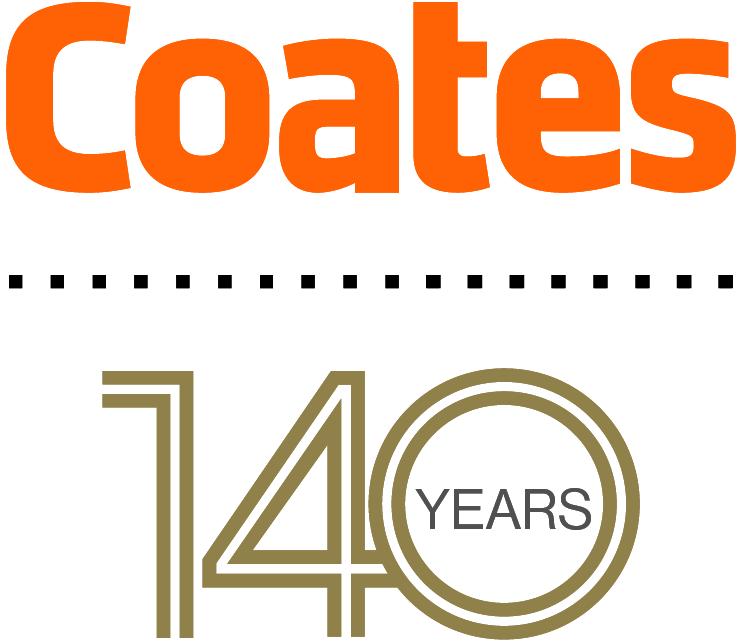



Discussion about this post